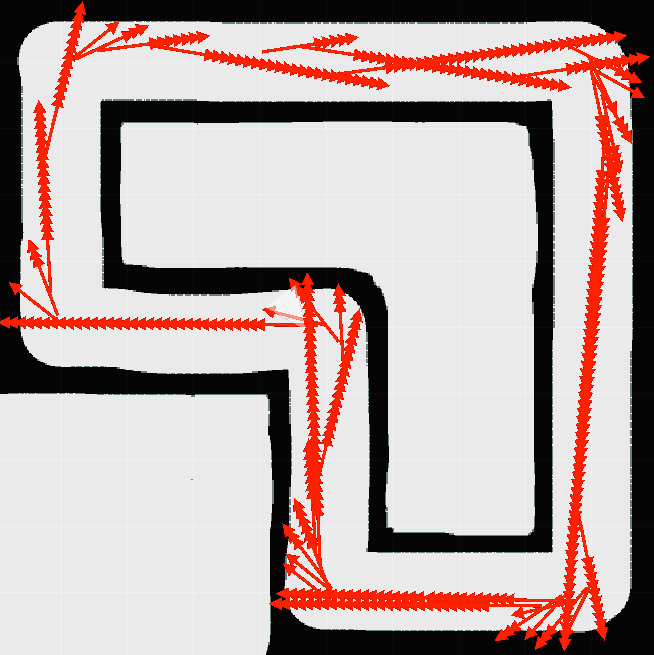matpalm / Drivebot
Programming Languages
Projects that are alternatives of or similar to Drivebot
drivebot
for more general info see the blog post
for more advanced RL experiments (with less of a focus on sim-real transfer learning) see cartpoleplusplus
for info on the physical rover build see this google+ collection
building drivebot ROS package
drivebot has two ROS specific components that need to be built.
- a
ActionGivenState.srvservice definition that describes how bots (real or simulated) interface with the NN policy - a
TrainingExample.msgmsg definition that describes training examples sent to the NN policy`
# build msg and service definitions
cd $ROOT_OF_CHECKOUT # whatever this is...
cd ros_ws
catkin_make
# add various ROS related paths to environment variables
# (add this to .bashrc if required)
source $ROOT_OF_CHECKOUT/ros_ws/devel/setup.bash
running ros env
stdr sim
roslaunch stdr_launchers server_no_map.launch
load map and add three bots...
rosservice call /stdr_server/load_static_map "mapFile: '$PWD/maps/track1.yaml'"
rosrun stdr_robot robot_handler add $PWD/maps/pandora_robot.yaml 5 5 0
rosrun stdr_robot robot_handler add $PWD/maps/pandora_robot.yaml 5 5 0
rosrun stdr_robot robot_handler add $PWD/maps/pandora_robot.yaml 5 5 0
optionally run gui (for general sanity) and rviz (for odom visulations)
roslaunch stdr_gui stdr_gui.launch
roslaunch stdr_launchers rviz.launch
running sim
start external policy
the policy represents the decision making process for bots.
policy is run in seperate process so it can support >1 bots. given stdr's limitations of not being able to run faster-than-real time the quickest way to train (apart from experience replay) is having multiple bots running.
$ ./policy_runner.py --help
usage: policy_runner.py [-h] [--policy POLICY] [--state-size STATE_SIZE]
[--q-discount Q_DISCOUNT]
[--q-learning-rate Q_LEARNING_RATE]
[--q-state-normalisation-squash Q_STATE_NORMALISATION_SQUASH]
[--gradient-clip GRADIENT_CLIP]
[--summary-log-dir SUMMARY_LOG_DIR]
[--summary-log-freq SUMMARY_LOG_FREQ]
[--target-network-update-freq TARGET_NETWORK_UPDATE_FREQ]
[--target-network-update-coeff TARGET_NETWORK_UPDATE_COEFF]
optional arguments:
-h, --help show this help message and exit
--policy POLICY what policy to use; Baseline / DiscreteQTablePolicy /
NNQTablePolicy
--state-size STATE_SIZE
state size we expect from bots (dependent on their
sonar to state config)
--q-discount Q_DISCOUNT
q table discount. 0 => ignore future possible rewards,
1 => assume q future rewards perfect. only applicable
for QTablePolicies.
--q-learning-rate Q_LEARNING_RATE
q table learning rate. different interp between
discrete & nn policies
--q-state-normalisation-squash Q_STATE_NORMALISATION_SQUASH
what power to raise sonar ranges to before
normalisation. <1 => explore (tends to uniform), >1 =>
exploit (tends to argmax). only applicable for
QTablePolicies.
--gradient-clip GRADIENT_CLIP
--summary-log-dir SUMMARY_LOG_DIR
where to write tensorflow summaries (for the
tensorflow models)
--summary-log-freq SUMMARY_LOG_FREQ
freq (in training examples) in which to write to
summary
--target-network-update-freq TARGET_NETWORK_UPDATE_FREQ
freq (in training examples) in which to flush core
network to target network
--target-network-update-coeff TARGET_NETWORK_UPDATE_COEFF
affine coeff for target network update. 0 => no
update, 0.5 => mean of core/target, 1.0 => clobber
target completely
run one bot
$ ./sim.py --help
usage: sim.py [-h] [--robot-id ROBOT_ID] [--max-episode-len MAX_EPISODE_LEN]
[--num-episodes NUM_EPISODES]
[--episode-log-file EPISODE_LOG_FILE]
[--max-no-rewards-run-len MAX_NO_REWARDS_RUN_LEN]
[--sonar-to-state SONAR_TO_STATE]
[--state-history-length STATE_HISTORY_LENGTH]
optional arguments:
-h, --help show this help message and exit
--robot-id ROBOT_ID
--max-episode-len MAX_EPISODE_LEN
--num-episodes NUM_EPISODES
--episode-log-file EPISODE_LOG_FILE
where to write episode log jsonl
--max-no-rewards-run-len MAX_NO_REWARDS_RUN_LEN
early stop episode if no +ve reward in this many steps
--sonar-to-state SONAR_TO_STATE
what state tranformer to use; FurthestSonar /
OrderingSonars / StandardisedSonars
--state-history-length STATE_HISTORY_LENGTH
if >1 wrap sonar-to-state in a StateHistory
common config includes
baseline
just go in direction of furthest sonar.
state is simply which sonar reads the furthest distance (0 for F, 1 for L and 2 for R) e.g. [0]
./policy_runner.py --policy Baseline
./sim.py --robot-id 0 --sonar-to-state FurthestSonar
./sim.py --robot-id 1 --sonar-to-state FurthestSonar
discrete state q table
q table with discrete states based on which sonar is reporting the furthest distance.
state is concat of history of last 4 readings; eg [0, 0, 1, 1]
./policy_runner.py --policy DiscreteQTablePolicy --q-state-normalisation-squash=50
./sim.py --robot-id 0 --sonar-to-state FurthestSonar
./sim.py --robot-id 1 --sonar-to-state FurthestSonar
continous state q learnt function
train a single layer NN using standardised sonar readings (mu and stddev derived from sample data for discrete state q table
./policy_runner.py --policy=NNQTablePolicy
--q-learning-rate=0.01 --q-state-normalisation-squash=50 --state-size=3
--summary-log-dir=summaries
./sim.py --robot-id=0 --sonar-to-state=StandardisedSonars
cookbook
state history variants
all sims.py can be run with --state-history-length=N to maintain state as a history of the last N sonar readings.
(i.e. stat is 3N floats, not just 3)
in the case of NNQTablePolicy we need to pass 3N as --state-size
training config
some config is expressed as ros parameters. these params are refreshed periodically by sim / trainer..
$ rosparam get /q_table_policy
{ discount: 0.9, # bellman RHS discount
learning_rate: 0.1, # sgd learning rate
state_normalisation_squash: 1.0, # action choosing squash; <1.0 (~0.01) => random choice, >1 (~50) => arg max
summary_log_freq: 100, # frequency to write tensorboard summaries
target_network_update_freq: 10} # frequency to clobber target network params
episode / event hacking for replay
( when --episode-log-file is not specified to sim.py we can extract it from recorded stdout. )
$ cat runs/foo.stdout | ./log_to_episodes.py
extract event jsonl from a log (one event per line)
$ cat runs/foo.log | ./log_to_episodes.py | ./episode_to_events.py
use previous date to calculate mean/std of ranges
$ cat runs/foo.log | ./log_to_episodes.py | ./calculate_range_standardisation.py
(68.56658770018004, 30.238156000781927)
rewrite the states for a run. every simualtion involves mapping from ranges -> states that are specific
for the policy being trained. by using ./rewrite_event_states.py we can rewrite the ranges (which are always the
same) to be a different state sequence. this can be used to build cirruculum style training data from
one policy (say a discrete q table) to be used by another policy (say an nn q table).
# rewrite an sequence of episodes so that events retain history of 10 states.
cat runs/foo.log \
| ./log_to_episodes.py \
| ./rewrite_event_states.py 10 \
> runs/foo_episodes_with_new_states.episode.jsonl
this data can then be piped through ./episode_to_events.py and shuffled to build batch experience replay training data.
e.g. replay a sequence of events (one per line) to the /drivebot/training_egs ros topic
# replay events in random order
cat runs/foo.episode.jsonl | ./episode_to_events.py | shuf | ./publish_events_to_topic.py --rate 1000
# rewrite episodes to have a history length of 5 then replay events in random order ad infinitum
cat runs/foo.episode.jsonl | ./log_to_episodes.py | ./episode_to_events.py > events.jsonl
while true; do shuf events.jsonl | ./publish_events_to_topic.py --rate=1000; done
stats
cat runs/foo.episode.jsonl | ./episode_stats.py > episode_id.num_events.total_reward.tsv

